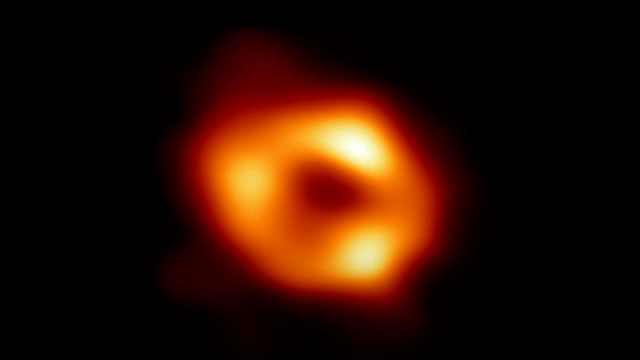 |
| ▲ A black hole centered on the Milky Way galaxy photographed with the Event Horizon Telescope (EHT) (Source: EHT YouTube broadcast screen) |
The scientists of the, "Event Horizon Telescope," Project (EHT), which has been observing black holes by connecting major radio telescopes around the world, held a press conference at 10 p.m. on the 12th in Washington and six other places simultaneously, to reveal the black hole image captured in the center of our galaxy. More than 300 researchers from 80 institutions around the world participated in the study. In Korea, Korean scientists at home and abroad, led by the Korea Astronomical Research Institute, participated and contributed, to achieve results. This is the first achievement in three years since April 2019, when the shadow of the supermassive black hole of the M87 Galaxy, about 55 million light years away from Earth, was captured and released.
Scientists said the achievement has secured direct visual evidence that the celestial body at the center of our galaxy is an ultra-mass black hole, and has gained valuable clues about the activities of such a huge celestial body. The black hole in the center of our galaxy, photographed by EHT, has a shadow of a black hole in the middle and a ring of red light surrounds it. The black hole in the center of our galaxy is also called Sagittarius A*, and was found in Sagittarius, about 27,000 light years away from Earth. The researchers explained that although the black hole of our galaxy is only one-thousandth of the M87 Galaxy, it is much smaller than the black hole of the M87 Galaxy, which is 4.3 million times the size of the Sun and 6.5 billion times the mass. Furthermore, it is incredibly difficult to capture the actual image because it is hidden by thick clouds of gas and dust. Although the black hole is small in mass, it is close to Earth, so the observed size was similar to that of the M87 Galaxy. In fact, the size of the black hole in the M87 Galaxy is about the entire solar system, but the black hole in our galaxy is about the distance from the sun to Mercury in diameter. "We will be able to reveal the formation and evolution of galaxies, and we expect new results, such as precise verification of general relativity through further research," the researchers said.
Just like when observing the galaxy, the M87 captured by EHT this time using VLBI technology, which connects eight radio telescopes, including the Atacama/Submillimeter Radio Interferometer (ALMA), and operates like a single telescope. This increases the sensitivity and resolving power of the telescope by building a global virtual telescope. EHT's resolving power was suggested to be sufficient to read newspaper letters in New York at cafes in Paris. As a result, the gravity of the black hole distorts light around the, "horizon of event," the entrance and boundary area of the black hole. It is possible to outline the, "shadow of the black hole," such as a ring-shaped structure, that shines brightly in orange and dark areas in the center. "The Sagittarius A* and other M87 black holes have very large mass differences and completely different shapes," said Sarah Markov, co-Chairman of the EHT Science Council. "This shows that Einstein's general theory of relativity is applied, and the difference between the two black holes is due to the material surrounding them." *
The general theory of relativity can be seen as proven, in that the shape of the black hole of the M87 Galaxy, which was first detected three years ago, is similar to the shape of the black hole disclosed on the same day. "I was surprised that the size of the black hole ring matches that suggested in general relativity," said Dr. Goffrey Bauer, an EHT Project Scientist at Taiwan's Central Institute for Astronomy and Astrophysics. "This achievement will greatly enhance our understanding of how supermassive black holes interact with their surroundings." The EHT scientists have begun to study the theory of analyzing the flow of attachments around supermassive black holes, that appear to be the origin of radio waves, which will reveal the formation and evolution of galaxies, as well as closely examine general relativity. Dr. Son Bong-won of the Korea Astronomical Research Institute said, "The Sagittarius A* black hole is the closest to the black hole directly observed by mankind due to collective intelligence," adding, "The Korea Astronomical Research Institute is preparing to participate in the joint ALMA (Atacama Large Millimeter/Submillimeter Array) and JCMT (James Clerk Maxwell Telescope).
As such, research on the universe in which we live is constantly being conducted. The shooting of the galaxy's black hole is to be an achievement that will remain celebrated in scientific history. Curiosity about the universe with infinite possibilities, will unlock the mysteries of the universe, one by one, through these discoveries.
By Jung In-hee, reporter sugar3870@naver.com
<저작권자 © The Campus Journal, 무단 전재 및 재배포 금지>

 Shrinkflation, Consumer Deception
Shrinkflation, Consumer Deception




